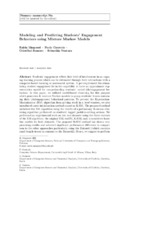Modeling and predicting students’ engagement behaviors using mixture Markov models
Autor
Maqsood, Rabia
Ceravolo, Paolo
Romero Morales, C.
Ventura Soto, S.
Editor
SpringerFecha
2022Materia
Student engagement behaviorMixture Markov models
Model-based clustering
Expectation-Maximization algorithm
K-means clustering
Sequential traces
Categorical data
METS:
Mostrar el registro METSPREMIS:
Mostrar el registro PREMISMetadatos
Mostrar el registro completo del ítemResumen
Students’ engagements reflect their level of involvement in an ongoing learning processwhich
can be estimated through their interactions with a computer-based learning or assessment
system. A pre-requirement for stimulating student engagement lies in the capability to have
an approximate representation model for comprehending students’ varied (dis)engagement
behaviors. In this paper, we utilized model-based clustering for this purpose which generates
K mixture Markov models to group students’ traces containing their (dis)engagement
behavioral patterns. To prevent the Expectation–Maximization (EM) algorithm from getting
stuck in a local maxima, we also introduced a K-means-based initialization method named
as K-EM. We performed an experimental work on two real datasets using the three variants
of the EM algorithm: the original EM, emEM, K-EM; and, non-mixture baseline models for
both datasets. The proposed K-EM has shown very promising results and achieved significant
performance difference in comparison with the other approaches particularly using the
Dataset1. Hence, we suggest to perform further experiments using large dataset(s) to validate
our method. Additionally, visualization of the resultant clusters through first-order Markov
chains reveals very useful insights about (dis)engagement behaviors depicted by the students.
We conclude the paper with a discussion on the usefulness of our approach, limitations and
potential extensions of this work.

